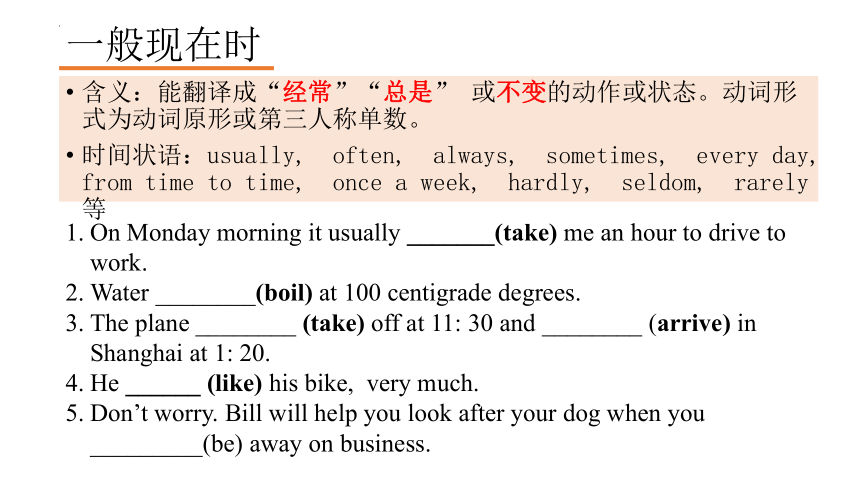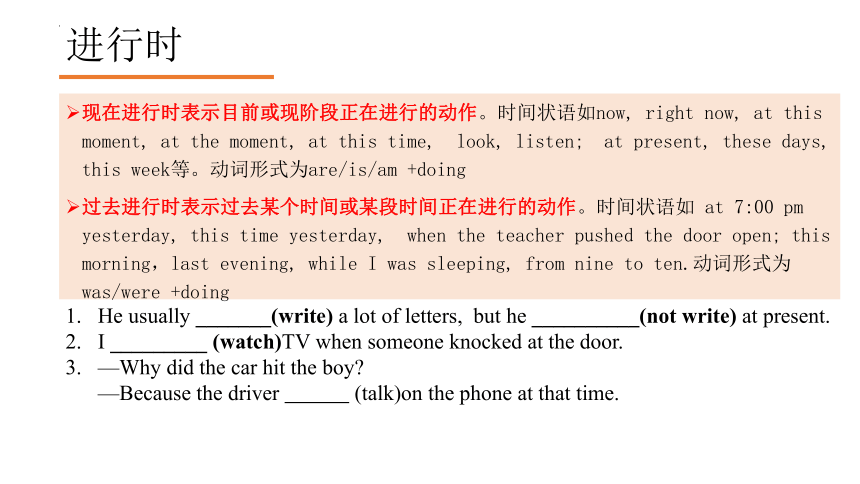2024届高考英语二轮复习:时态语态 课件(共10张PPT)
文档属性
| 名称 | 2024届高考英语二轮复习:时态语态 课件(共10张PPT) |  | |
| 格式 | pptx | ||
| 文件大小 | 80.6KB | ||
| 资源类型 | 教案 | ||
| 版本资源 | 通用版 | ||
| 科目 | 英语 | ||
| 更新时间 | 2023-09-05 21:17:28 | ||
图片预览





文档简介
(共10张PPT)
第10讲 时态语态
高中英语基础知识系列
我们已经学过哪些时态?
每个时态的含义是什么?
不同时态下的被动语态的结构形式是什么?
导学问题
一般现在时
含义:能翻译成“经常”“总是” 或不变的动作或状态。动词形式为动词原形或第三人称单数。
时间状语:usually, often, always, sometimes, every day, from time to time, once a week, hardly, seldom, rarely等
On Monday morning it usually _______(take) me an hour to drive to work.
Water ________(boil) at 100 centigrade degrees.
The plane ________ (take) off at 11: 30 and ________ (arrive) in Shanghai at 1: 20.
He ______ (like) his bike, very much.
Don’t worry. Bill will help you look after your dog when you _________(be) away on business.
表示过去某个时间发生的动作或存在的状态, 与现在无关。常用yesterday, last year, in 1995, the other day等作时间状语,动词形式为过去式。
一般过去时
He _________(work) very hard last year.
Miss Zhang (订购)a dress online two weeks ago, but it hasn t arrived yet.
—How come you are late again —I because my alarm clock didn’t go off.(oversleep)
When I (arrive) at the hotel, it was midnight.
现在进行时表示目前或现阶段正在进行的动作。时间状语如now, right now, at this moment, at the moment, at this time, look, listen; at present, these days, this week等。动词形式为are/is/am +doing
过去进行时表示过去某个时间或某段时间正在进行的动作。时间状语如 at 7:00 pm yesterday, this time yesterday, when the teacher pushed the door open; this morning,last evening, while I was sleeping, from nine to ten.动词形式为was/were +doing
进行时
He usually _______(write) a lot of letters, but he __________(not write) at present.
I _________ (watch)TV when someone knocked at the door.
—Why did the car hit the boy
—Because the driver (talk)on the phone at that time.
现在完成时
过去发生的动作,延续到现在或对现在造成了影响。时间状语如:never, ever, before, already, just, yet, recently, so far, by now, up to now, for+一段时间,since, in the past, over the years.动词形式为have/has +过去分词
I _______ (live) in Ningbo for many years.
Since the pre-Qin period, Chengdu 56 _________ (be) an important cultural town in China. (2023.4宁波二模)
I love coming here and seeing my family and all the friends I (make) over the years.
①It is/has been+时间段+ since. . . 表示“自从……以来已经……”。
*It is/has been ten years since I graduated from university.
②This/It/That is the first/second/third. . . time that. . . 表示“这/那是(某人)第几次做某事”, that从句中要用现在完成时。
*This is the first time that I have been here.
被动语态
1 一般现在时 is/am/ are done
2 一般过去时 was/were done
3 一般将来时 will be done
4 现在进行时 is/am/are being done
5 过去进行时 was/were being done
6 现在完成时 have/has been done
A new road (build)near my school next year.
Everybody (move)deeply after they heard the story.
When you (give)a difficult task, try to stick with it and finish it.
The shopping mall ______________ (close) since the accident happened.
Children should (educate)to be honest from a young age.
小结
含义 状语 动词形式 被动语态
1 一般现在时 能翻译成“_____”“______” 或不变的动作或状态。 动词原形或____________ is/am/ are done
2 一般过去时 表示___________________发生的动作或存在的状态, 与现在无关。 过去式 _______________
3 一般将来时 将来某时要发生的动作或状态 will do/be going to do ______________
4 现在进行时 表示目前或_______正在进行的动作。 _______________ is/am/are being done
5 过去进行时 表示过去某个时间或_________正在进行的动作 _______________ was/were being done
6 现在完成时 过去发生的动作,延续到_____或对现在造成了______。 have/has +过去分词 _______________
Since 1920, the Olympic rings ____40____ (use) in every summer and winter Games.
Miss Zhang (order订购)a dress online two weeks ago, but it ______________(not arrive)yet.
I saw Jeff in the park. He (sit)on the grass and reading a book.
My mother (be)a good example for me since I was young.
Last week Professor Li ____ (invite)to make a speech on Chinese traditional festivals.
Teenagers should (educate) to take care of themselves from a young age.
课堂测试
第10讲 时态语态
高中英语基础知识系列
我们已经学过哪些时态?
每个时态的含义是什么?
不同时态下的被动语态的结构形式是什么?
导学问题
一般现在时
含义:能翻译成“经常”“总是” 或不变的动作或状态。动词形式为动词原形或第三人称单数。
时间状语:usually, often, always, sometimes, every day, from time to time, once a week, hardly, seldom, rarely等
On Monday morning it usually _______(take) me an hour to drive to work.
Water ________(boil) at 100 centigrade degrees.
The plane ________ (take) off at 11: 30 and ________ (arrive) in Shanghai at 1: 20.
He ______ (like) his bike, very much.
Don’t worry. Bill will help you look after your dog when you _________(be) away on business.
表示过去某个时间发生的动作或存在的状态, 与现在无关。常用yesterday, last year, in 1995, the other day等作时间状语,动词形式为过去式。
一般过去时
He _________(work) very hard last year.
Miss Zhang (订购)a dress online two weeks ago, but it hasn t arrived yet.
—How come you are late again —I because my alarm clock didn’t go off.(oversleep)
When I (arrive) at the hotel, it was midnight.
现在进行时表示目前或现阶段正在进行的动作。时间状语如now, right now, at this moment, at the moment, at this time, look, listen; at present, these days, this week等。动词形式为are/is/am +doing
过去进行时表示过去某个时间或某段时间正在进行的动作。时间状语如 at 7:00 pm yesterday, this time yesterday, when the teacher pushed the door open; this morning,last evening, while I was sleeping, from nine to ten.动词形式为was/were +doing
进行时
He usually _______(write) a lot of letters, but he __________(not write) at present.
I _________ (watch)TV when someone knocked at the door.
—Why did the car hit the boy
—Because the driver (talk)on the phone at that time.
现在完成时
过去发生的动作,延续到现在或对现在造成了影响。时间状语如:never, ever, before, already, just, yet, recently, so far, by now, up to now, for+一段时间,since, in the past, over the years.动词形式为have/has +过去分词
I _______ (live) in Ningbo for many years.
Since the pre-Qin period, Chengdu 56 _________ (be) an important cultural town in China. (2023.4宁波二模)
I love coming here and seeing my family and all the friends I (make) over the years.
①It is/has been+时间段+ since. . . 表示“自从……以来已经……”。
*It is/has been ten years since I graduated from university.
②This/It/That is the first/second/third. . . time that. . . 表示“这/那是(某人)第几次做某事”, that从句中要用现在完成时。
*This is the first time that I have been here.
被动语态
1 一般现在时 is/am/ are done
2 一般过去时 was/were done
3 一般将来时 will be done
4 现在进行时 is/am/are being done
5 过去进行时 was/were being done
6 现在完成时 have/has been done
A new road (build)near my school next year.
Everybody (move)deeply after they heard the story.
When you (give)a difficult task, try to stick with it and finish it.
The shopping mall ______________ (close) since the accident happened.
Children should (educate)to be honest from a young age.
小结
含义 状语 动词形式 被动语态
1 一般现在时 能翻译成“_____”“______” 或不变的动作或状态。 动词原形或____________ is/am/ are done
2 一般过去时 表示___________________发生的动作或存在的状态, 与现在无关。 过去式 _______________
3 一般将来时 将来某时要发生的动作或状态 will do/be going to do ______________
4 现在进行时 表示目前或_______正在进行的动作。 _______________ is/am/are being done
5 过去进行时 表示过去某个时间或_________正在进行的动作 _______________ was/were being done
6 现在完成时 过去发生的动作,延续到_____或对现在造成了______。 have/has +过去分词 _______________
Since 1920, the Olympic rings ____40____ (use) in every summer and winter Games.
Miss Zhang (order订购)a dress online two weeks ago, but it ______________(not arrive)yet.
I saw Jeff in the park. He (sit)on the grass and reading a book.
My mother (be)a good example for me since I was young.
Last week Professor Li ____ (invite)to make a speech on Chinese traditional festivals.
Teenagers should (educate) to take care of themselves from a young age.
课堂测试
